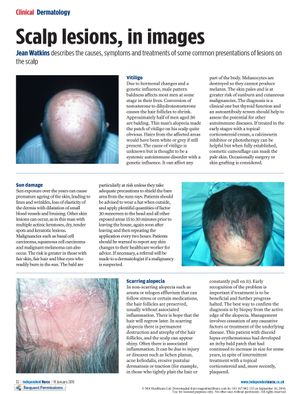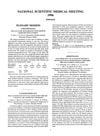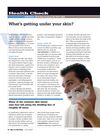Scalp Lesions: Causes, Symptoms, and Treatments
January 2015
in “
Independent Nurse
”
actinic keratoses basal cell carcinoma squamous cell carcinoma malignant melanoma vitiligo scalp alopecia topical creams phototherapy non-scarring alopecia alopecia areata telogen effluvium scarring alopecia trichotillomania folliculitis keloidalis erosive pustular dermatosis systemic antibiotics topical steroids cylindroma skin cancer autoimmune disorder hair loss hair regrowth hair pulling inflammation scarring antibiotics steroids benign tumor

TLDR Different scalp conditions can lead to hair loss or tumors, with treatments varying from creams to surgery; early detection is crucial.
The document provides an overview of various scalp lesions, their causes, symptoms, and treatments. Sun damage can lead to actinic keratoses and malignancies like basal cell carcinoma, squamous cell carcinoma, and malignant melanoma, with bald individuals at higher risk. Vitiligo, an autoimmune disorder, can make scalp alopecia more noticeable and is treated with topical creams or phototherapy. Non-scarring alopecia, such as areata or telogen effluvium, offers hope for hair regrowth, while scarring alopecia results in permanent follicle destruction. Trichotillomania, a psychological condition, leads to compulsive hair pulling, and folliculitis keloidalis causes inflammation and scarring at the nape of the neck, often in black males. Erosive pustular dermatosis, common in the elderly, requires systemic antibiotics and topical steroids. Cylindroma, a benign tumor, can be solitary or multiple, with the latter potentially leading to serious complications and requiring surgical excision. The document emphasizes the importance of early diagnosis and regular follow-up for these conditions.





